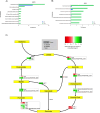This is a preprint.
Carbapenem-resistant Acinetobacter baumannii (CRAB): metabolic adaptation and transcriptional response to human urine (HU)
- PMID: 38853891
- PMCID: PMC11160873
- DOI: 10.21203/rs.3.rs-4415275/v1
Carbapenem-resistant Acinetobacter baumannii (CRAB): metabolic adaptation and transcriptional response to human urine (HU)
Update in
-
Carbapenem-resistant Acinetobacter baumannii (CRAB): metabolic adaptation and transcriptional response to human urine (HU).Sci Rep. 2024 Aug 19;14(1):19145. doi: 10.1038/s41598-024-70216-w. Sci Rep. 2024. PMID: 39160175 Free PMC article.
Abstract
Carbapenem-resistant Acinetobacter baumannii (CRAB) is a major human pathogen and a research priority for developing new antimicrobial agents. CRAB is a causative agent of a variety of infections in different body sites. One of the manifestations is catheter-associated urinary tract infection, which exposes the bacteria to the host's urine, creating a particular environment. Exposure of two CRAB clinical isolates, AB5075 and AMA40, to human urine (HU) resulted in the differential expression levels of 264 and 455 genes, respectively, of which 112 were common to both strains. Genes within this group play roles in metabolic pathways such as phenylacetic acid (PAA) catabolism, the Hut system, the tricarboxylic acid (TCA) cycle, and other processes like quorum sensing and biofilm formation. These results indicate that the presence of HU induces numerous adaptive changes in gene expression of the infecting bacteria. These modifications presumably help bacteria establish and thrive in the hostile conditions in the urinary tract. These analyses advance our understanding of CRAB's metabolic adaptations to human fluids, as well as expanding knowledge on bacterial responses to distinct human fluids containing different concentrations of human serum albumin (HSA).
Keywords: Acinetobacter baumannii; carbapenem-resistance; cefiderocol; human serum albumin; human urine.
Conflict of interest statement
Conflicts of Interest: The authors declare no conflict of interest.
Figures




Similar articles
-
Carbapenem-resistant Acinetobacter baumannii (CRAB): metabolic adaptation and transcriptional response to human urine (HU).Sci Rep. 2024 Aug 19;14(1):19145. doi: 10.1038/s41598-024-70216-w. Sci Rep. 2024. PMID: 39160175 Free PMC article.
-
Induced Heteroresistance in Carbapenem-Resistant Acinetobacter baumannii (CRAB) via Exposure to Human Pleural Fluid (HPF) and Its Impact on Cefiderocol Susceptibility.Int J Mol Sci. 2023 Jul 21;24(14):11752. doi: 10.3390/ijms241411752. Int J Mol Sci. 2023. PMID: 37511511 Free PMC article.
-
Acinetobacter baumannii response to cefiderocol challenge in human urine.Sci Rep. 2022 May 24;12(1):8763. doi: 10.1038/s41598-022-12829-7. Sci Rep. 2022. PMID: 35610334 Free PMC article.
-
Prospective role of cefiderocol in the management of carbapenem-resistant Acinetobacter baumannii infections: Review of the evidence.Int J Antimicrob Agents. 2023 Aug;62(2):106882. doi: 10.1016/j.ijantimicag.2023.106882. Epub 2023 Jun 8. Int J Antimicrob Agents. 2023. PMID: 37301312 Review.
-
Cefiderocol and Sulbactam-Durlobactam against Carbapenem-Resistant Acinetobacter baumannii.Antibiotics (Basel). 2023 Dec 14;12(12):1729. doi: 10.3390/antibiotics12121729. Antibiotics (Basel). 2023. PMID: 38136764 Free PMC article. Review.
References
-
- Tacconelli E. et al. Discovery, research, and development of new antibiotics: the WHO priority list of antibiotic-resistant bacteria and tuberculosis. The Lancet Infectious Diseases 18, 318–327 (2018). - PubMed
-
- Kumar S. et al. Prospective surveillance of device-associated health care–associated infection in an intensive care unit of a tertiary care hospital in New Delhi, India. American Journal of Infection Control 46, 202–206 (2018). - PubMed
Publication types
Grants and funding
LinkOut - more resources
Full Text Sources
Molecular Biology Databases

